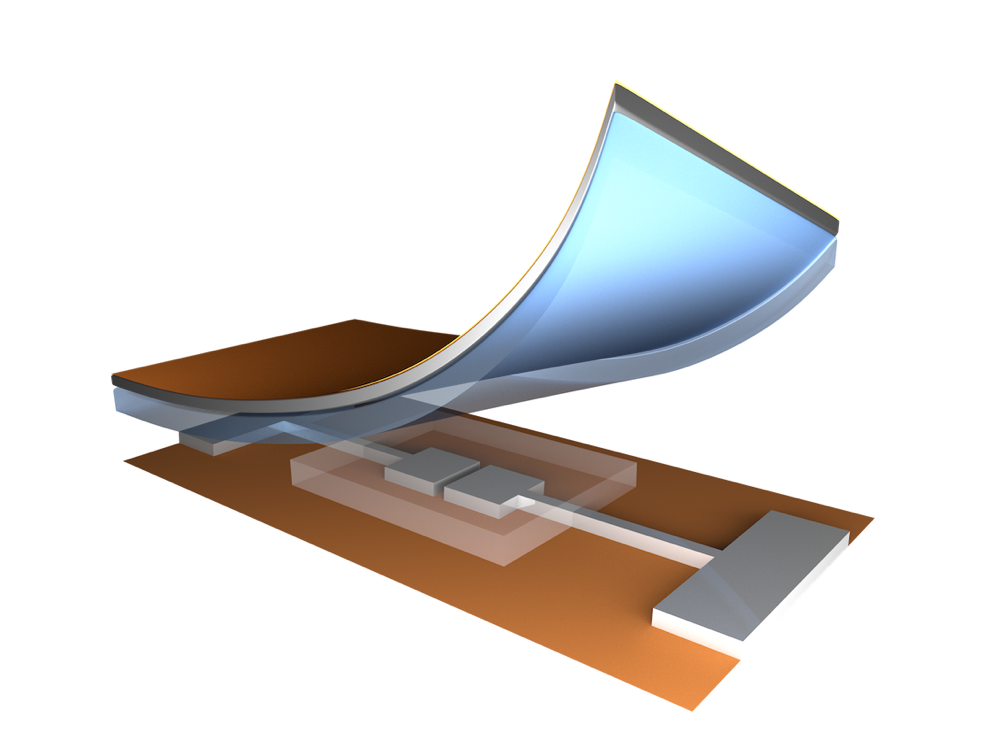What is Ionic Liquid

Ionic liquids are composed of positive and negative ions (cations and anions) and are nonvolatile, biocompatible, and flame retardant. When voltage is applied, ionic liquids form a very thin 1 nm gap, called the electric double layer, at the electrode-ionic liquid interface. This layer acts as a capacitor, and the ionic liquid exhibits a very large capacitance (several µF/cm2). Ionic gels, which have the properties of ionic liquids dispersed in polymers, are attracting attention as electronic materials.
イオン液体は,正と負のイオン(カチオン,アニオン)から構成され,不揮発性,生体適合性,難燃性を示す。イオン液体は電圧が印加されると,電極-イオン液体界面に電気二重層と呼ばれる非常に薄い1 nmギャップを形成する。この層はキャパシタとして振る舞うため,イオン液体は非常に大きな静電容量(数 µF/cm2)を示す。このイオン液体をポリマー中に分散して,イオン液体の特性を有するイオンゲルが電子材料として注目を集めている。
Eco-friendly Ionic Gel
The Internet of Things (IoT), in which various “objects” are equipped with wireless sensor terminals and connected to the Internet, has attracted much attention, and it is estimated that the number of wireless sensor terminals used in the Internet is 10 trillion. However, when these wireless sensor terminals are discarded, it is assumed that they will be discarded in the environment because they cannot be recovered due to their huge number. Therefore, supercapacitors and lithium-ion batteries, which use hazardous materials among electronic components, are considered to trigger serious environmental pollution by leaking from wireless sensor terminals. In this study, we are conducting research and development of environmentally friendly electronics by fabricating ion gels using ionic liquids and polymers with environmentally benign properties. Furthermore, focusing on the biocompatibility of ionic liquids, we are developing body-friendly, minimally invasive flexible devices.
様々な”モノ”に無線センサ端末を搭載して,インターネットに接続するInternet of Things (IoT)が注目を集めており,その使用される無線センサ端末は10兆個になると試算されている。しかしながら,これら無線センサ端末が破棄される場合,膨大な数のため回収できず,環境中に破棄されると想定される。このため,電子部品の中でも有害な材料を使用するスーパーキャパシタ,リチウムイオン電池は,無線センサ端末から流出して深刻な環境汚染の引き金になると考えられる。本研究では,環境調和性を持つイオン液体とポリマーを用いてイオンゲルを作製して,環境に優しいエレクトロニクスの研究開発を実施している。さらに,イオン液体の生体適合性に注目して,体に優しい低侵襲性のフレキシブルデバイスの開発に取り組んでいる。
S. Yamada, et al., Small, vol. 14, no. 32, p. 1800937, Jun. 2018.
Tactile Sensor
 Human skin is a typical sensory organ that not only protects the human body but also has various sensors on its surface and inside. If the sensing mechanism of the skin can be mimicked by electronics, it is expected to be possible to give human sensation to conventional robots and artificial hands, and various artificial skin electronic-skins (e-skins) have been developed. Among sensors, tactile sensors can detect pressure, the most basic physical quantity, and highly sensitive and accurate sensors have been reported. In this study, we have developed a method of detecting pressure with a drain current using an oxide semiconductor and an ion gel. When pressure is applied, the ion-gel forms a channel at the semiconductor interface and increases the drain current by four orders of magnitude. This has enabled us to realize a tactile sensor with very high sensitivity to pressure changes of 1-10 kPa. We will further develop this research to develop a novel wearable device, Ionic-skin (i-skin), which uses ions as the sensing principle.
Human skin is a typical sensory organ that not only protects the human body but also has various sensors on its surface and inside. If the sensing mechanism of the skin can be mimicked by electronics, it is expected to be possible to give human sensation to conventional robots and artificial hands, and various artificial skin electronic-skins (e-skins) have been developed. Among sensors, tactile sensors can detect pressure, the most basic physical quantity, and highly sensitive and accurate sensors have been reported. In this study, we have developed a method of detecting pressure with a drain current using an oxide semiconductor and an ion gel. When pressure is applied, the ion-gel forms a channel at the semiconductor interface and increases the drain current by four orders of magnitude. This has enabled us to realize a tactile sensor with very high sensitivity to pressure changes of 1-10 kPa. We will further develop this research to develop a novel wearable device, Ionic-skin (i-skin), which uses ions as the sensing principle.
人の皮膚は,人間の体を保護するだけでなく,様々なセンサが表面・内部に存在した代表的な感覚器官である。この皮膚のセンシング機構をエレクトロニクスで模倣できれば,従来のロボットや義手に人の感覚を付与することができると期待されており,さまざまな人工皮膚Electronic-skin(e-skin)が開発されている。。センサのなかでもタクタイルセンサは,最も基本的な物理量である圧力を検出でき,高感度,高精度なセンサが報告されている。本研究では,酸化物半導体とイオンゲルを用いて,圧力をドレイン電流で検出する方式を開発した。圧力が印加されるとイオンゲルは半導体界面にチャネルを形成して,ドレイン電流を4桁増大する。このため,圧力変化1~10 kPaに対して,非常に大きな感度を持つタクタイルセンサを実現できた。本研究をさらに発展させ,イオンをセンシング原理にした新規のウェラブルデバイスIonic-skin(i-skin)の開発を目指す。
S. Yamada, et al., Appl. Phys. Lett., vol. 110, 2017, pp. 253501-1-4.



